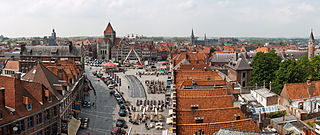
Tournai or Tournay is a city and municipality of Wallonia located in the Province of Hainaut, Belgium. It lies 89 km (55 mi) by road southwest of the centre of Brussels on the river Scheldt, and is part of Eurometropolis Lille–Kortrijk–Tournai, In 2022, the municipality of Tournai had an estimated population of 68,518 people.
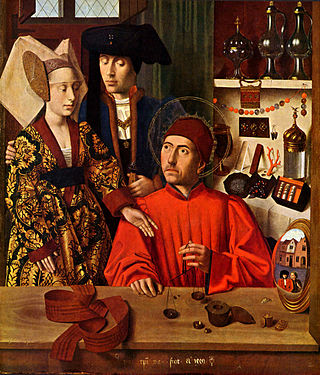
Eligius, venerated as Saint Eligius, was a Frankish goldsmith, courtier, and bishop who was chief counsellor to Dagobert I and later Bishop of Noyon–Tournai. His deeds were recorded in Vita Sancti Eligii, written by his friend Audoin of Rouen.
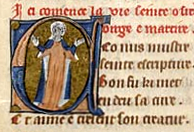
Osgyth was a Mercian noblewoman and prioress, venerated as an English saint since the 8th century, from soon after her death. She is primarily commemorated in the village of St Osyth, in Essex, near Colchester. Alternative spellings of her name include Sythe, Othith and Ositha. Born of a noble family, she became a nun and founded a priory near Chich which was later named after her.

Arnold (Arnoul) of Soissons or Arnold or Arnulf of Oudenburg is a saint of the Catholic Church, the patron saint of hop-pickers, Belgian brewers.

Matilda of Scotland, also known as Good Queen Maud, or Matilda of Blessed Memory, was Queen of England and Duchess of Normandy as the first wife of King Henry I. She acted as regent of England on several occasions during Henry's absences: in 1104, 1107, 1108, and 1111.

Edith of Wilton was an English saint, nun and member of the community at Wilton Abbey, and the daughter of Edgar, King of England and Saint Wulfthryth. Edith's parents might have been married and Edgar might have abducted Wulfthryth from Wilton Abbey, but when Edith was an infant, Wulfthryth returned with Edith and their marriage was dissolved. Edith and her mother remained at Wilton for the rest of their lives.

The Archdiocese of Cambrai is a Latin Church ecclesiastical jurisdiction or archdiocese of the Catholic Church in France, comprising the arrondissements of Avesnes-sur-Helpe, Cambrai, Douai, and Valenciennes within the département of Nord, in the region of Nord-Pas-de-Calais. The current archbishop is Vincent Dollmann, appointed in August 2018. Since 2008 the archdiocese has been a suffragan of the Archdiocese of Lille.

Medardus or Medard was the Bishop of Noyon. He moved the seat of the diocese from Vermand to Noviomagus Veromanduorum in northern France. Medardus was one of the most honored bishops of his time, often depicted laughing, with his mouth wide open, and therefore he was invoked against toothache.
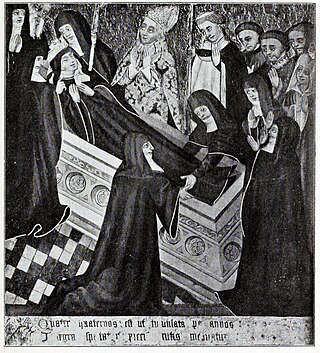
Seaxburh, also Saint Sexburga of Ely, was an Anglo-Saxon queen and abbess, venerated a saint of the Christian Church. She was married to King Eorcenberht of Kent.

Saint Gummarus of Lier is a Belgian saint. He was the son of the Lord of Emblem. An official in the court of his relative Pepin the Younger or Pepin of Herstal according to some other sources, after a number of years in military service he retired to live the life of a hermit. The town of Lier grew up around his hermitage.

Cistercian nuns are female members of the Cistercian Order, a religious order belonging to the Roman Catholic branch of the Catholic Church.
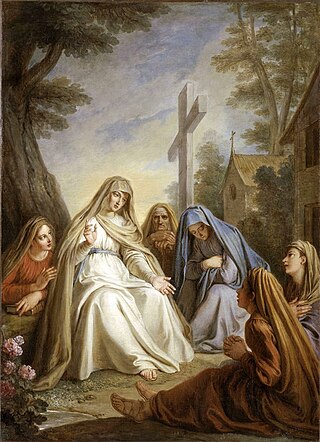
Landrada of Austrasia was a German saint and ascetic. She co-founded Munsterbilsen Abbey, which was dedicated to the Virgin Mary. Landrada's feast day is 8 July. She is the patroness saint of Munsterbilsen and Ghent.

Godeberta was a saint and abbess. She was born of "pious parents" in Amiens, France, north of Paris. Her parents were nobles attached to the king's court, so she was carefully educated. When Godeberta was old enough, her father took her to the king's court to obtain permission to "marry her to someone of suitable rank and fortune". Saint Eligius, who was present at court, was able to see that she wanted to "dedicate her virginity to God", and took off his episcopal ring and placed it on her finger in the presence of the king, pronouncing her a nun. Godeberta refused offers of marriage by her noble suitors, and the king, impressed with her zeal and conduct, endowed Godeberta with a small palace in nearby Noyon, north of France, with a chapel dedicated to Saint George. She turned her home into a monastery, where she was abbess for 12 young women. She chose Eligius as her spiritual guide.
Saint Edith of Polesworth is an Anglo-Saxon abbess associated with Polesworth (Warwickshire) and Tamworth (Staffordshire) in Mercia. Her historical identity and floruit are uncertain. Some late sources make her a daughter of King Edward the Elder, while other sources claim she is the daughter of Egbert of Wessex. Her feast day is 15 July.
The Bibliotheca Hagiographica Graeca is a catalogue of Greek hagiographic materials, including ancient literary works on the saints' lives, the translations of their relics, and their miracles, arranged alphabetically by saint. It is usually abbreviated as BHG in scholarly literature. The listings include MSS, incipits, and printed editions. The first two editions were edited by the Bollandists, which included the Jesuit scholar Hippolyte Delehaye. The most recent editions have been the product of a single editor François Halkin. The BHG along with the Bibliotheca Hagiographica Latina and Bibliotheca Hagiographica Orientalis are the most useful tools in the research of literary documents concerning the saints.
Margaret “the Lame” of Magdeburg (1210–1250) was an anchoress of the St. Albans Church in Magdeburg. There she spent her days and years in total renunciation of the world in order to give honor to God. People believed she received visions from the Lord and her experiences were later documented in Vita Margaretae Contractae.
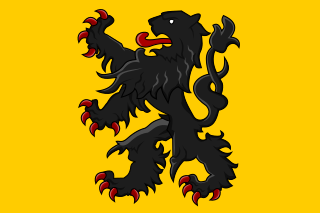
The County of Flanders was one of the most powerful political entities in the medieval Low Countries, located on the North Sea coast of what is now Belgium. Unlike its neighbours such as the counties of Brabant and Hainaut, it was within the territory of the Kingdom of France. The counts of Flanders held the most northerly part of the kingdom, and were among the original twelve peers of France. For centuries, the economic activity of the Flemish cities such as Ghent, Bruges and Ypres made Flanders one of the most affluent regions in Europe, and also gave them strong international connections to trading partners.
Adalsinda or Adalsindis of Hamay and Eusebia of Douai, were 7th-century Columban nuns, who were sisters from a prominent Merovingian family; Eusebia became an Abbess. They are venerated as saints in the Catholic and Eastern Orthodox Churches. Their parents were Richtrudis, a Gascoigne-Basque heiress, and Adalbard I of Ostrevent, a Frankish duke of Douai. Both mother and father are also recognised as saints, as are another sister, Clotsinda, and a brother, Maurontius. They are especially venerated in Northern France and Flanders.

Ten Putte Abbey is a monastery with an abbey in Gistel, roughly 8 km to the south of Ostend, in the western part of Belgium. It was built to mark the spot where, in 1070, Saint Godelina was murdered by strangulation and then thrown into a pond. Before 2007 the abbey was home to nine Benedictine nuns, who were members of the wider Subiaco Cassinese Congregation in West Flanders. Since 2007 it has been occupied by brothers and sisters of the "Mother of Peace" community.
















